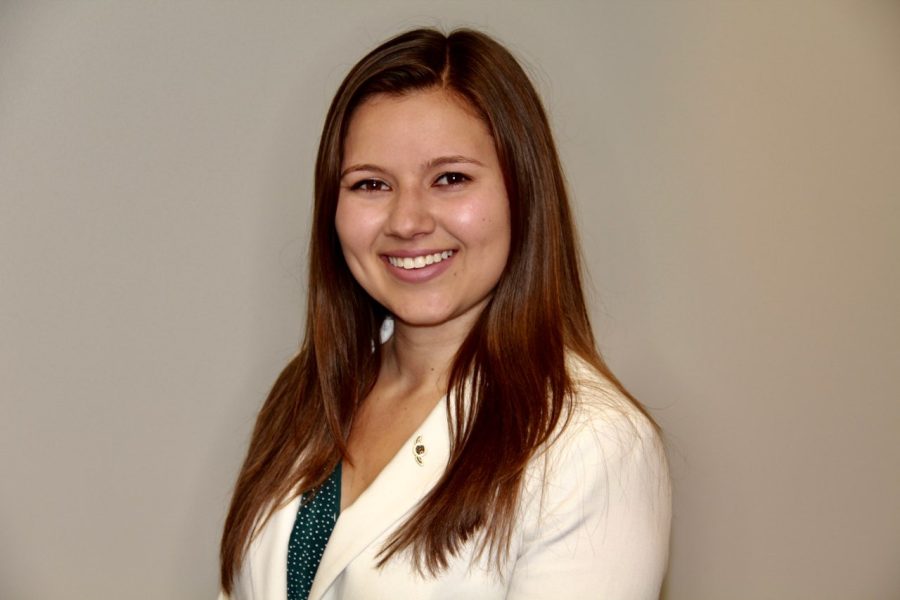Sydney Bihn becomes Kent State’s first female aerospace engineering graduate
June 15, 2020
Sitting in her class about how to teach science in middle childhood, Sydney Bihn watched as her classmates got up one after another to present how they planned to integrate various women in science into their unit plans.
It was nearing the end of her sixth semester as a middle childhood education major at Kent State and Bihn felt pretty comfortable about her future career as an educator. But watching the presentations, she couldn’t help but start to wonder. She liked science and math and she was smart enough to have gone down the science path—so why hadn’t she?
Bihn didn’t have an answer to that question, but she kept thinking about it. In fact, she couldn’t stop thinking about it, even as she started to wrap up her junior year.
“I realized that I was 21 [at the time] and that was not the time in your life to say what you could or could not do, or that it’s too late to do something,” Bihn said. “You still can [do something.]”
Eventually, she told her then-boyfriend about how she was thinking about switching majors.
“Don’t just let it go,” he said. “Look into it.”
Bihn turned to Google, researching different career paths in science. She took personality tests, shadowed people she knew in different fields of science and reached out to people on LinkedIn. By the end of her research, Bihn knew; she wanted to be an engineer. She loved math and was hopeful the science aspect of engineering would push her to apply that math to the real world.
“I felt like what I was really lacking was something really challenging for me,” Bihn said. “Something I knew would kind of push me out of what I know how to do and what I’m good at and pushed me to try to be just as good at something else but have to work at it more. I felt like engineering would fulfill that for me.”
But Kent State wasn’t known for its engineering program. Bihn started to prepare herself for the possibility of having to transfer. The University of Akron was close by, she thought, that could be nice. Or she could go home to Toledo and attend the University of Toledo. Switching schools wasn’t something she wanted to do—but it could be necessary if she wanted to be an engineer.
Before making a decision, she went to talk to one of the advisors in Kent State’s College of Aeronautics and Engineering. The meeting was to talk about the engineering technology degrees at Kent State, but the advisor instead told Bihn about the new aerospace engineering degree at Kent State and asked her to talk to Blake Stringer.
Stringer, the founding faculty member of the aerospace engineering program, wanted to know what made her want to change majors. Bihn explained her drive to find something she was passionate about that challenged her. Stringer’s second question was, “where are you in your math?” Bihn told him she had taken Calculus 1.
“How did you do?” Stringer asked.
“I missed two points,” Bihn answered.
“Two points,” Stringer said.
“Two points in the whole course,” Bihn clarified.
“Two points in the whole course, you’re in,” Stringer said.
Bihn’s personality and drive had impressed Stringer and he helped her set up a program that would allow her to graduate with the degree’s first graduating class in three years. Bihn didn’t have to start from scratch.
“Her first semester [in the program] she was just such a hard charger,” Stringer said “Two months in, she had gotten her own internship, through her own channels. She did it all on her own.”
Her years of studying education helped her as well, as she was able to give Stringer constructive feedback into the coursework that was being offered for the program.
“She was very vocal about wanting things for students,” Stringer said. “Saying, ‘hey, how about we take a course in this,’ or ‘we really need a course in that.’ Just really good constructive feedback.”
In 2019, Bihn became a Brooke Owens Fellow. The Brooke Owens Fellowship is a paid internship for undergraduate women seeking a career in aviation or space exploration. It’s a prestigious program, with students from more than 125 universities in 13 different countries applying. 38 students were selected to join in 2019.
“Her being a Brooke Owens fellow, and all the other things that she did, she really did a lot to enhance the credibility of our program,” Stringer said. “I’m going to miss her, I’ll tell you that.”
Bihn was often the only woman in her aerospace engineering classes, classes that were made up of 12 to 15 students. Engineering is often pointed to as the most male-dominated profession in the United States. According to the U.S. Bureau of Labor Statistics, in 2016 women made up only 13 percent of the engineering workforce.
She graduated in May along with Kent State’s first aerospace engineering graduating class. Bihn is the first woman to graduate at Kent State with an aerospace engineering degree.
“About 15 percent of engineers in our country are women,” Bihn said. “But those numbers are significantly smaller for women of color. And yes, I am the first woman to graduate from this program. But I’m also white, and very often the first woman is white and that’s unfortunate. It’s difficult, yes, to be the only woman in the room, but I can’t even imagine being the only woman while also being a woman of color. We definitely have a lot of work to do to keep encouraging women of all backgrounds to join this field.”
After graduation, she moved to Arizona to start a job as an associate manufacturing engineer at Northrop Grumman.
“I kind of have no idea where this is going to take me,” Bihn said. “But so far, I’ve only been able to do incredible things as an engineer.”
Contact Gina Butkovich at [email protected]





















